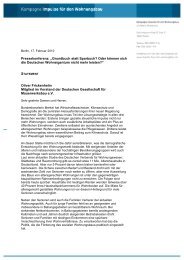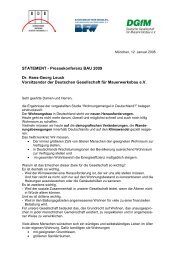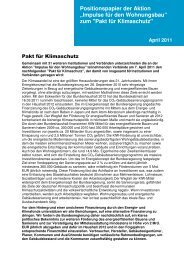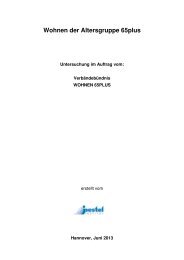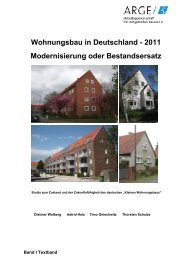BFW-Studie - European Union of Developers and House Builders
BFW-Studie - European Union of Developers and House Builders
BFW-Studie - European Union of Developers and House Builders
You also want an ePaper? Increase the reach of your titles
YUMPU automatically turns print PDFs into web optimized ePapers that Google loves.
<strong>BFW</strong>-Study<br />
Pol<strong>and</strong> <strong>and</strong> Sweden) are particularly progressive in this area, whereas such housing<br />
models are not <strong>of</strong>fered yet in Romania, Latvia, Turkey or in other Eastern <strong>European</strong><br />
countries.<br />
The segment <strong>of</strong> barrier-free housing or housing adapted to the needs <strong>of</strong> senior citizens accounts<br />
for an average market share <strong>of</strong> approximately one percent <strong>of</strong> the entire housing<br />
stock in <strong>European</strong> countries <strong>and</strong> the trend is growing. In Germany the proportion <strong>of</strong><br />
homes suitable for the elderly is approximately one percent, whereas Belgium <strong>and</strong> the<br />
Netherl<strong>and</strong>s dominate with shares <strong>of</strong> two <strong>and</strong> five percent.<br />
The highly ambitious policy on the elderly in these countries since the 1970s <strong>and</strong> 1980s<br />
in particular has sharply advanced the development <strong>of</strong> homes catering for the elderly.<br />
Moreover, construction for the elderly in Belgium also makes compromises in favour <strong>of</strong><br />
low-barrier adaptations to homes <strong>and</strong> involves fewer regulations.<br />
The one percent share in Germany must therefore be significantly raised in the medium<br />
term to cope with the challenges resulting from demographic change. Given current assumptions<br />
<strong>and</strong> according to the estimates <strong>of</strong> market experts, at least a further 800,000<br />
homes must be adapted to cater for the elderly or newly built for out-patient care by<br />
2020. This is both to cope with increasing dem<strong>and</strong> <strong>and</strong> to take pressure <strong>of</strong>f healthcare insurance<br />
which will record a deficit in the foreseeable future.<br />
More alternative forms <strong>of</strong> housing<br />
instead <strong>of</strong> full in-patient nursing care<br />
New <strong>and</strong> innovative forms <strong>of</strong> housing are gaining in importance throughout Europe, <strong>and</strong><br />
are leading to a trend away from accommodation in full inpatient nursing homes, as these<br />
are increasingly being viewed as a type <strong>of</strong> exclusion. Housing models such as multi-generation<br />
houses as well as residential group models in particular are establishing themselves<br />
as alternatives. The latter differentiate themselves in one respect as sheltered housing<br />
communities enjoying tenant status, with a rental contract for their living space in a large<br />
new building or the housing stock <strong>and</strong> where care is provided exclusively through outpatient<br />
nursing services.<br />
On the other h<strong>and</strong>, in-patient sheltered residential groups exist as an integrated care concept<br />
in pre-in-patient nursing institutions or housing communities linked to nursing<br />
homes, set up separately in a normal residential environment with special legal regulations.<br />
Alternative forms <strong>of</strong> accommodation for senior citizens exist in 11 <strong>of</strong> the 13 countries<br />
surveyed. Residential group models dominate here, but these are not subject to any legal<br />
or other regulations in most countries <strong>and</strong> are not subsidised.<br />
Trend towards independent living<br />
Elderly people with increased care, support, or nursing requirement need special residential<br />
<strong>and</strong> care facilities so that they can live a self determined life for a long time. To allow<br />
this, buildings catering to the needs <strong>of</strong> the elderly via special building features are<br />
24 <strong>BFW</strong>-Study 2007




